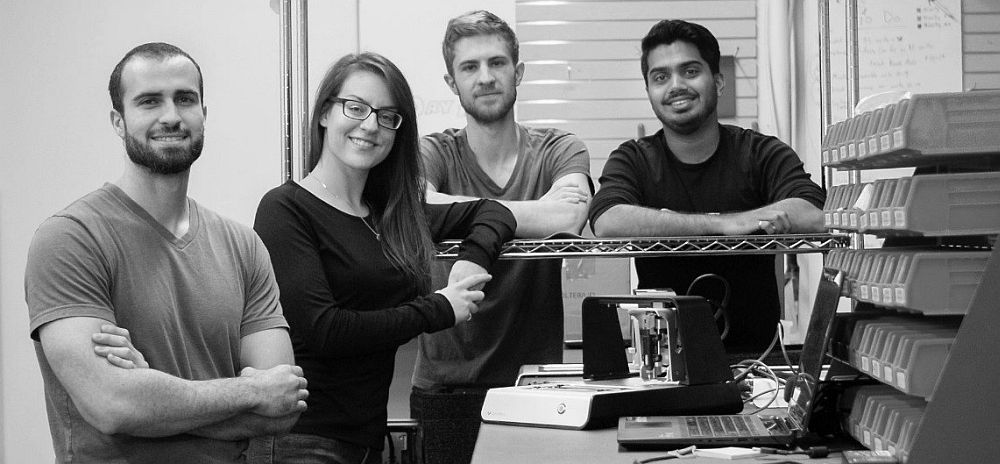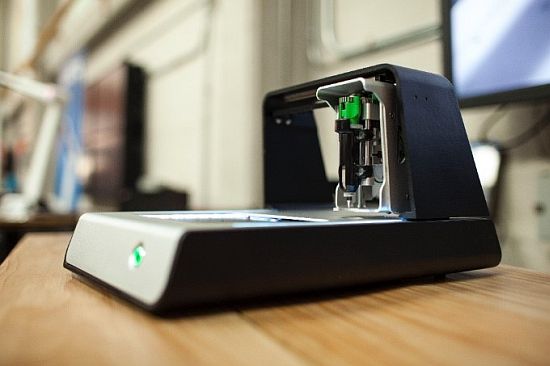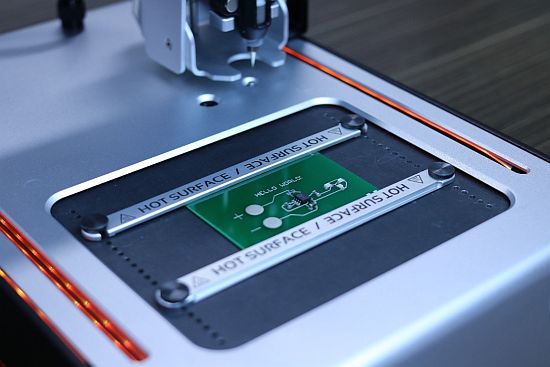In some circles, the study of nanotechnology has a reputation for leading to a career in research. One of University of Waterloo’s successful nanotechnology engineering undergraduate students, Katarin Ilic (class of 2013), knows firsthand that it can also be a springboard to many other exciting opportunities.

Voltera founders: Jesús Zozaya, Katarina Ilic, James Pickard and Alroy Almeida
Her nanotechnology expertise played an integral role in the creation of a disruptive new product – a custom circuit board printer that was recently recognized with an International James Dyson Award. The Voltera V-One won the award for Voltera, a company founded by University of Waterloo graduates Alroy Almeida, James Pickard, Jesús Zozaya and Katarina Ilic.
The printed circuit board (PCB) fabricator uses custom-formulated, highly conductive silver nanoparticle paste, insulating ink and solder paste, along with electronic components, to create circuitry on a lightweight fiberglass board. This new equipment creates functioning circuit boards quickly and cost-effectively. Users can build a circuit board on site for tens of dollars, versus having one made overseas for hundreds of dollars, saving money and time, as well as frustration, when multiple design iterations are required.
The Voltera team is well-experienced with the frustrations and triumphs of multiple designs. To achieve their vision, they needed their control software and dispensing mechanisms to work perfectly with their ink, and that proved to be a challenge.
Katarina’s nanotechnology expertise was instrumental in developing ink that could flow through printer heads, yet retain its shape and maintain the high silver content required for good conductivity. The technology is based on silver nano-particles, which allow the ink to have a fluid like consistency and be dispensed accurately through a tiny nozzle. Once the circuit pattern is deposited, the ink is thermally cured. During this process, the solvent evaporates and polymerization is initiated, bringing the silver nano-particles together to form a tight silver matrix. At the end of the process, the silver traces are conductive and solder-able.
The Voltera team worked through several iterations and three technologies before they identified the perfect combination of technology and material for their circuit board printer. As Ilic says, “It was like starting over three times!”
The group persevered, despite hearing many doubts that their idea would ever come to fruition, and has been rewarded with good success for their efforts. Since the team graduated in 2013, they have incorporated their company, created their product from scratch in Waterloo’s Velocity Garage, and then launched, manufactured and marketed the Voltera V-One. The company has tripled in size to meet the requirements of its current stage of development.
Looking back on the lessons she’s learned, Katarina remarks on nanotechnology’s reputation as a research-focused specialty. “That’s simply not true,” she states. “There is enormous movement in the field. If you can open your mind to being creative, you can make something applicable to the real world.”
She encourages nanotechnology students to think of their potential to create early in their studies, when they have access to a wealth of resources. “Mentors, labs, characterization equipment…it’s all here at Waterloo. Take advantage of it.”

The Voltera V-One

Voltera circuit board